A failure upon release, Ray Bradbury’s “Something Wicked This Way Comes” is a timeless treasure that has cemented its place in genre history.
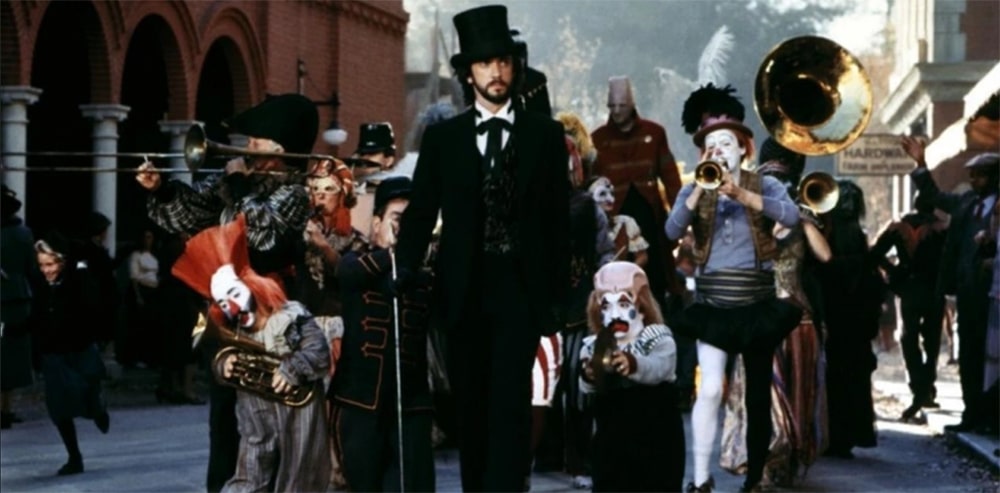
As a child of the ‘80s, it was a constant struggle for me to reconcile my love of horror with my parents’ Puritanical suspicion of anything dark or gothic in the age of the Satanic Panic.
That’s why I secretly did the dance of joy when Disney decided to throw their hats in the horror ring with Watcher in the Woods (1980) and Something Wicked This Way Comes (filmed in 1982, released in ‘83). After all, if wholesome Disney was willing to bookend its constant family programming on The Disney Channel with horror titles, could the genre really be all that evil?
Disney even went so far as to broadcast Halloween specials during the fall months, including their classic The Adventures of Ichabod and Mr. Toad (1949) “Legend of Sleepy Hollow” treatment and a showcase of spooky cartoons and family movies from the previous decades, from The Skeleton Dance (1929) to Blackbeard’s Ghost (1968), not to mention the terrifying demon from the “Night on Bald Mountain” segment of Fantasia (1940).
One of the things I most vividly recall is a “behind the scenes” special they did, The Making of Something Wicked This Way Comes (1983).
Of particular interest was a discussion of a scene during which the forces of evil converge on the protagonists in the form of a cluster of tarantulas and the difficulties of using so many real spiders vs. mechanical ones. But I don’t want to get too far ahead of myself.
This piece will be a little different from my usual fare (consisting mainly of newly released independent horror film reviews).
I co-opted it from one of my fellow writers at Morbidly Beautiful, who was not only kind enough to allow me to take over the article (she will be doing a retrospective on Watcher in the Woods, which I cannot wait to read) but also sent me a copy of the Blu-ray as well as the audio commentary from the 1996 laserdisc release, featuring author Ray Bradbury, Stephen Burum (director of photography), and Harrison Ellenshaw (special effects consultant).
Thank you, Ms. Laura, from the bottom of my boogedy, boogedy heart.
WICKED ORIGINS
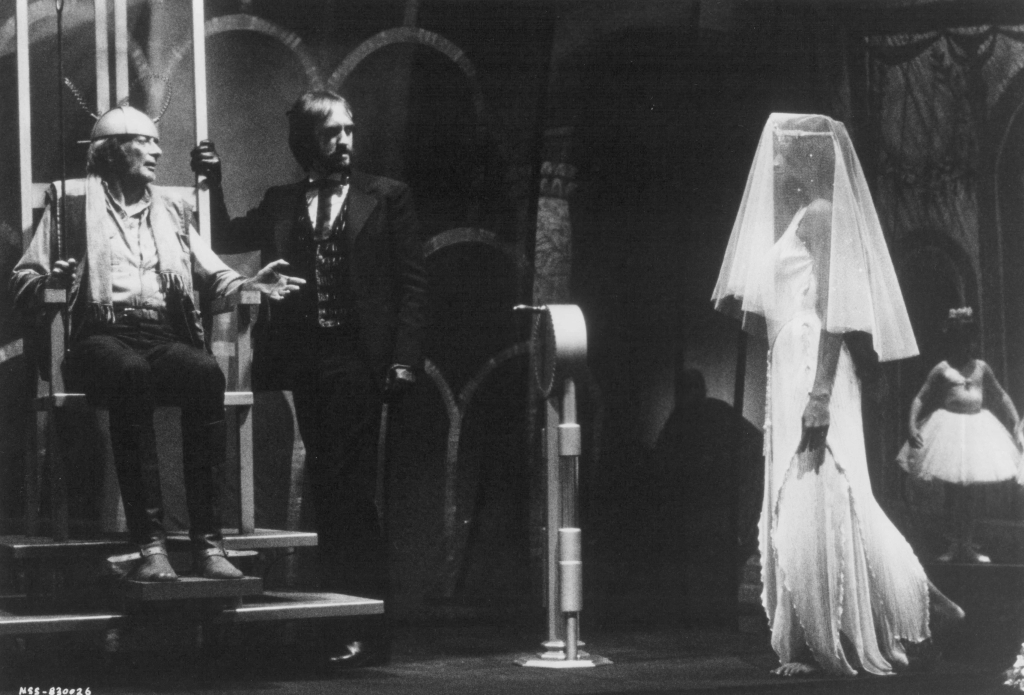
The title itself is an allusion to Shakespeare’s Macbeth from the weird sisters who, in Act 4, Scene 1, hear the titular villain knocking at their door and intone, “By the pricking of my thumbs, something wicked this way comes. Open, locks, Whoever knocks!” At that point in the play, we realize that Macbeth’s ambitions have made him so evil that wicked creatures of the night even genuflect to him.
In a way, Something Wicked This Way Comes is a sort of hub for all things Bradbury.
There is a character called “Mr. Electrico” in the story, named after a carnival magician whom Bradbury met when he was around the age of the novel’s protagonists (12). The carnie introduced the future Pulitzer, Hugo, and Emmy winner to a host of freak show performers and dubiously told the lad to “live forever!” and that he was the reincarnation of a dead WWI soldier.
This so inspired his imagination that he credits the encounter with jumpstarting his career as an author of dark and fantastical stories.
The main antagonist of Something Wicked, Mr. Dark, is nicknamed The Illustrated Man.
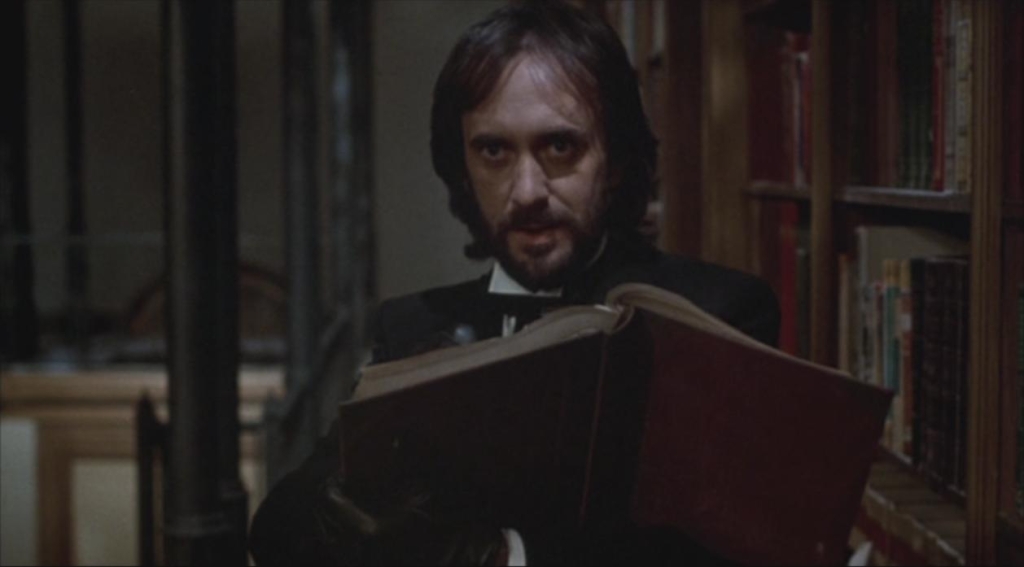
This is also the name of the storyteller in Bradbury’s 1951 book of short stories and subsequent 1969 movie of the same title due to his body being covered from head to toe with living illustrations.
In the novel, Mr. Dark has this same condition, though oddly enough, this aspect of the character was dropped from the film with the small exceptions of a writhing wrist tattoo and tattoos of the protagonists’ faces on his palms, probably due to a combination of budgetary constraints and lack of practicality.
The idea for the story came from Bradbury brainstorming with his friend, film and dance legend Gene Kelly, about a collaboration based on Bradbury’s 1948 short story “The Black Ferris” (which was adapted for television on Ray Bradbury Theater in the late ‘80s) and featured many of the same themes, including an evil carnival, an age reversing ride, two boys coming of age, and even characters named Mr. Cooger and Ms. Foley, who feature in both the novel and film versions of Something Wicked This Way Comes.
“The Black Ferris” is basically the story of Mr. Cooger, an evil carnie who uses a Ferris wheel (instead of a carousel) to disguise himself as a child and get up to no good in an unsuspecting small town. Just as in the later novel and film, two coming-of-age boys try to stop him.
Unfortunately, Kelly could not get funding for the project during a trip to Europe designed for that purpose. It was shelved, with Bradbury eventually turning the updated treatment of his short story into a full-length novel published in 1962.
WRITE THIS WAY
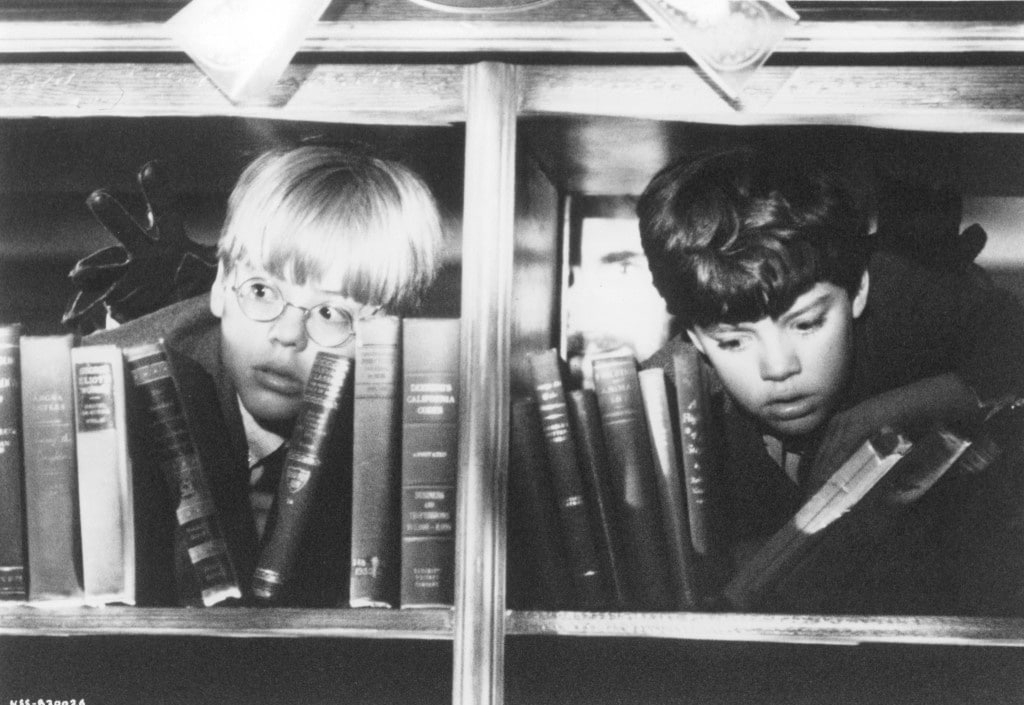
When I think of 1962, I think of Gypsy (no offense to any Romani), starring Natalie Wood (who is buried only a few feet away in the same cemetery as Mr. Bradbury) but not any horror films, which makes me a little sad.
My father would have been eight years old, the same age I was during the Disney release of Something Wicked. But apart from Carnival of Souls, 1962 was not a great year for horror…films, that is.
Thankfully, Bradbury released his novel alongside several other great titles that became part of the public subconsciousness, including Shirley Jackson’s We Have Always Lived in the Castle and Robert Bloch’s Atoms and Evil: Robert Bloch’s Tales of Terror.
If you’re as much of a fan of Stephen King as I am, you’ll appreciate that Bradbury, Bloch, and Jackson all released books around the time of his formative years as a young writer. He discusses this at length in his non-fiction love letter to the horror genre, Danse Macabre (1981), as well as Something Wicked This Way Comes specifically, which also gets mentions in The Dead Zone, Salem’s Lot, and Needful Things (which contains heavily similar themes).
Besides King, English writer Neil Gaiman (The Sandman, Coraline) also credits Bradbury as a major influence and stated in an article following Bradbury’s death in 2012 that his 2001 novel American Gods can be read as a tribute to Something Wicked This Way Comes.
Children’s horror author R.L. Stine (Goosebumps, Fear Street) said, “I always tell people that the scariest book I ever read was Something Wicked This Way Comes.”
The novel has been published by major publishing houses seven times and can be found in audio form on YouTube and Audible.
HERE THEY COME
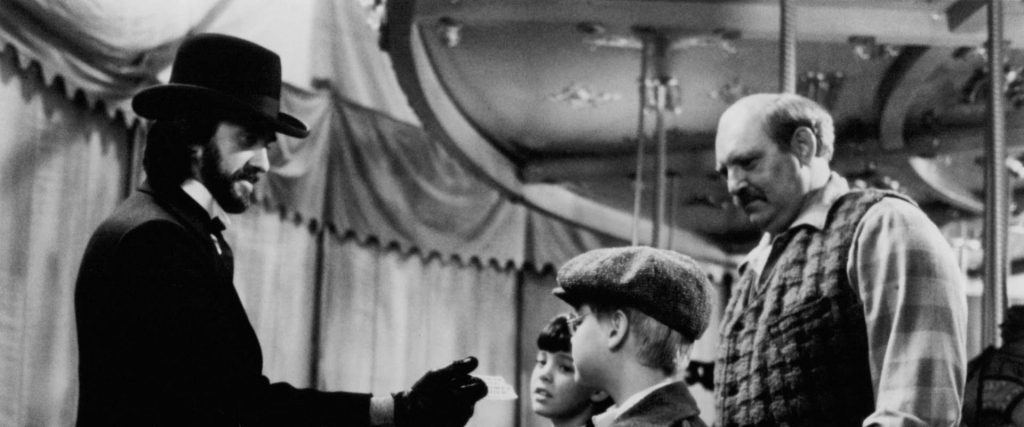
To my knowledge, there are eight versions of Something Wicked This Way Comes, seven of which were released to the public.
These include the 1962 novel; a horrible 1972 BBC-produced, made-for-TV short (which has nothing to recommend it apart from some interesting early ‘70s synth music); the 1983 Disney film; a short-lived 2003 play based on the novel; a 2007 and later 2011 radio play; and a 2015 Off-Off-Broadway musical.
The one which was never released was Disney’s 1982 version of the movie. Disney had completed an earlier version of the film, which did so poorly with test audiences that they decided to scrap nearly the entire thing, including the original soundtrack by Academy Award winner Georges Delerue (Platoon, Beaches, Steel Magnolias).
I have listened to the unused Delerue score, and I can tell you that, without a doubt, it is far darker than the James Horner (Aliens) score used in the finished product.
That said, the Horner score is still, in my humble opinion, the better overall as it is more age-appropriate and invokes more of a sense of nostalgia. It works the way Goldsmith’s Poltergeist (1982) soundtrack did in that it is light where it needs to be and horrifying enough not to overwhelm the viewer while enhancing the scariest scenes.
Disney was wise to make the change; however, for those who are curious, the original score has been uploaded to YouTube.
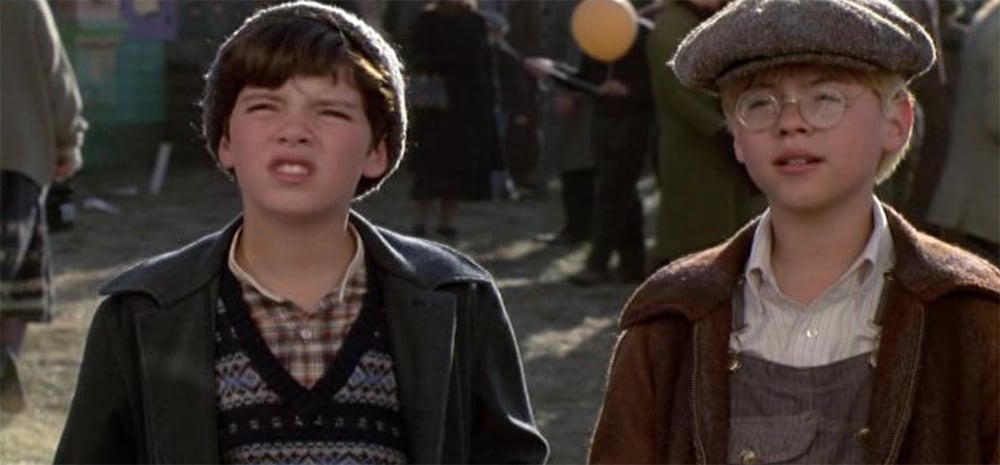
Something else that was uploaded to YouTube, and very recently, by The Center for Ray Bradbury Studies at Indiana University School of Liberal Arts, is a brief video about the Center’s discovery of the original version…on a videotape.
The CRBS has a huge archive of Bradbury memorabilia, and on the box of the unassuming video tape, it says, in Bradbury’s handwriting, “First Version! Rejected!”
People are already begging the CRBS to digitize the footage in the comments sections before it is lost forever to the ravages of time. According to the senior advisor, there’s a scene at the end of the original version where one of the protagonists and his father do a song and dance number cut from the final film. Hopefully, this lost piece of cinematic history will be released to the public someday.
According to several sources, among the other casualties of the lost version was an animation scene which would have been among the first uses of CGI in a Hollywood film.
The sequence involved the carnival train arriving and then essentially “transforming” from a train into the carnival itself. The deleted scene is described in detail in the June 1983 issue of Twilight Zone Magazine.
Also, on the cutting room floor (and on that tape) is a scene with a giant animatronic hand that menaces the boys instead of the tarantulas. Disney decided it didn’t look real enough.
A PLOT TO DIE FOR
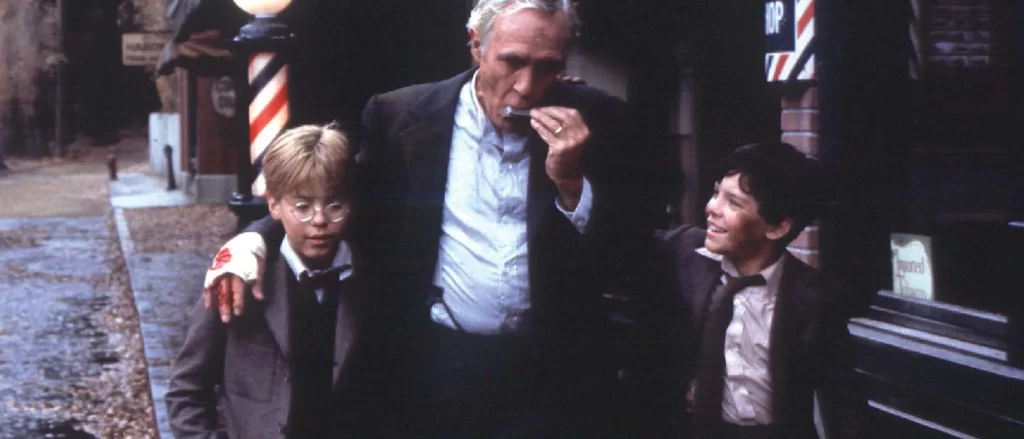
Spoilers abound, so if you haven’t seen the movie yet, please check it out first.
One of the things I love the most about the final version is its slew of taglines which, in my opinion, are perfect (and most would fit Needful Things just as well):
– “After he fulfills your deepest, lifelong dream…he’ll tell you the price you have to pay.”
– “Don’t whisper your dreams, someone may be listening.” [UK]
– “Something frightening. Something strange. Something different.”
– “Ray Bradbury’s classic tale of shadowy dreams come true.”
– “What would you give a man who could make your deepest dreams come true?”
The movie, of course, had to be stripped down to its core to present the novel’s material in its more than reasonable 95-minute running time.
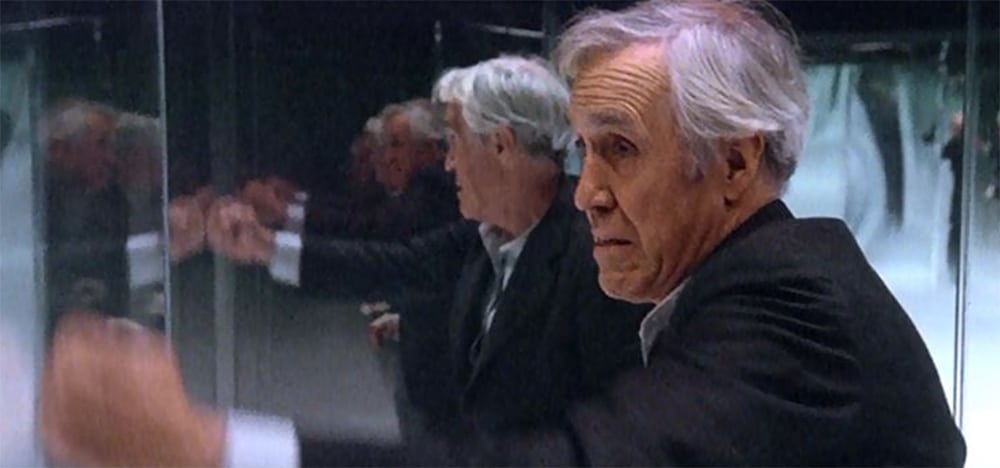
After several rewrites stretching back to 1958 (when it was still being formed from “The Black Ferris”), the plot we end up with in the movie is basically the same as the novel and is about as American Gothic as it gets.
Two boys, Will Halloway (Vidal Peterson) and Jim Nightshade (Shawn Carson), are next-door neighbors and best friends in the small town of Green Town, Illinois. The boys were born one minute apart on Halloween and are looking forward to becoming official teenagers in a few weeks and the carnival that comes at the same time every year.
But, as the narrator ominously informs us, “One year, the carnival came early…”
An eclectic lightning rod salesman (Royal Dano, House II: The Second Story, Killer Klowns from Outer Space) tells the boys a storm’s a-brewin’ and convinces Jim to purchase one of the rods, which he promptly installs on his house (a wise move, as it later turns out).
In the meantime, a mysterious man in black distributes pamphlets around the neighborhood inviting everyone to Cooger and Dark’s Pandemonium Shadow Show. But it turns out that this isn’t the same carnival that the boys are used to. Rather, this one only comes every few decades.
We are introduced to several of the townspeople, including:
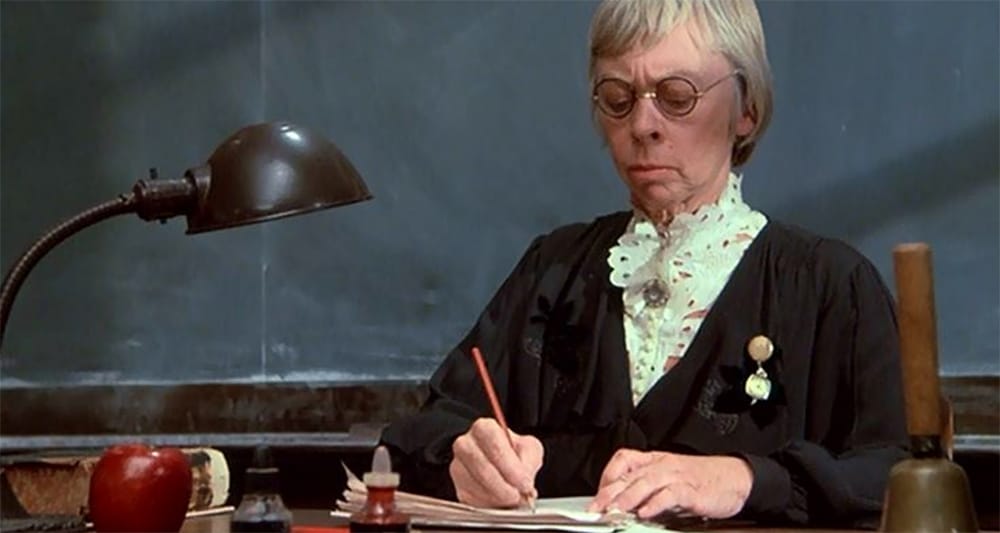
– Will’s Father, Charles Halloway (Jason Robards), is the town’s librarian who carries around deep regret that he has not made more of his life in his 54 years and that the father of his son’s best friend once saved his son from drowning while he watched, helplessly. (In the novel, he is merely the janitor at the library.)
– Jim’s mother (Diane Ladd) pretends like the father who abandoned her and Jim is coming back someday, though she can’t help but invite door-to-door salesmen in for tea.
– The town barber, Mr. Crosetti (Richard Davalos), dreams of one day being surrounded by exotic women.
– Ed the Bartender (James Stacy), a highly functioning amputee, is always reliving his glory days as a former local football hero.
– Mr. Tetley (Jake Dengel) always daydreams of what he would do if he were rich.
– Miss Foley (Mary Grace Canfield) is a somewhat homely schoolteacher who is rumored to have once been a Grecian beauty.
There is plenty of interaction between them, setting a lovely small-town backdrop for the film and introducing the audience to several backstories and major plot points in the process.
The villains are soon introduced as well, including:
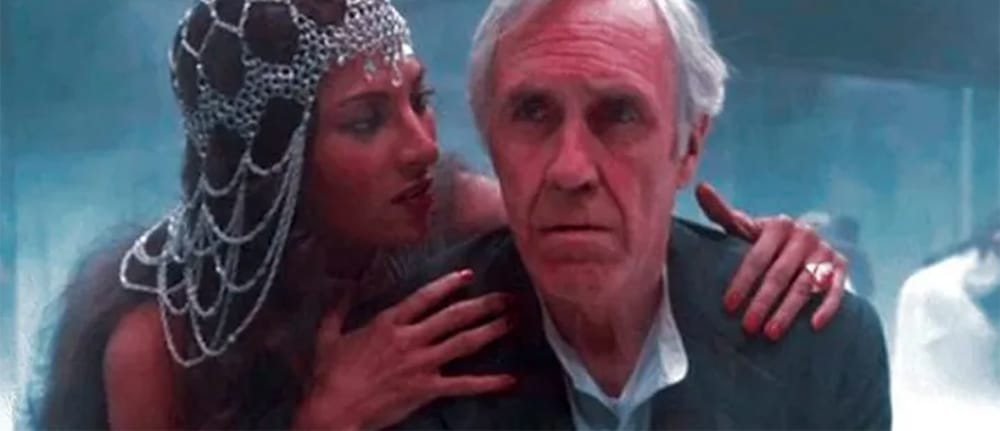
– Mr. Dark (a.k.a. “The Illustrated Man” in the novel) is played to utter perfection by Sir Jonathan Pryce. He is the ringleader of the carnival and one of The Autumn People, who may be hundreds of years old and seems to feed off of fear and guilt. With the other carnival attendants’ assistance, he also exploits his victims’ dreams and ambitions by promising to fulfill them…for a nasty price.
– Mr. Cooger (Bruce M. Fischer) is the co-owner of the carnival who disguises himself as a child (Brendan Klinger) by riding in reverse on a magic carousel and, though it is never fully explained, tricks Miss Foley into believing he is her nephew, undoubtedly for some sinister purpose.
– The Dust Witch (played by the legendary Pam Grier, who was trying to shed her hot ’70s detective image) is a beautiful but deadly sorceress who can hypnotize men and bend the forces of nature to her will.
Assisting these baddies are a couple of creepy dwarfs (including Angelo Rossitti from Tod Browning’s Freaks and Mad Max: Beyond Thunderdome) and some magical attractions, including the aforementioned age-reversing carousel, a Ferris wheel that appears to devour people, and a hall of mirrors which not only disorients those who enter but shows them their greatest desire which it promises to fulfill.
Later, Mr. Dark uses the mirrors to show Will’s father his greatest regret and promises him a second chance at making better decisions in his youth.
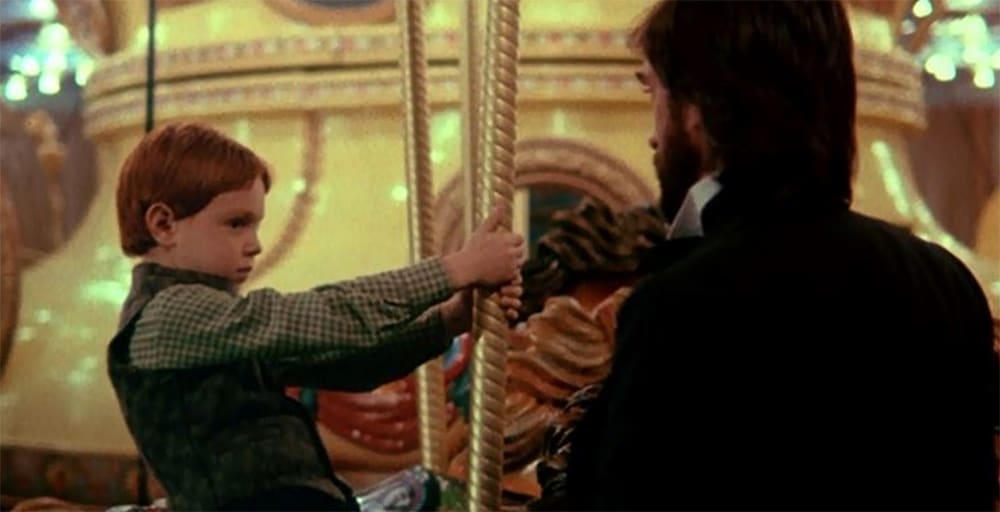
After Mr. Dark has successfully turned the townspeople (including the lightning rod salesman who was seduced by the Dust Witch) into sideshow freaks (the price for having their wildest dreams come true), he goes after the boys who are onto his sinister plans after witnessing Mr. Cooger’s age reversal on the carousel. The boys also see Mr. Dark tormenting the lightning rod salesman and using the Dust Witch to coax the “secret of the storm” out of him before the boys are spotted.
Dark then sends the Dust Witch after them, who attacks them with spiders but is defeated by the lighting rod that Jim had installed earlier.
In perhaps the most effective scene in the film, Dark then brings the carnival to the town the next day in a parade to search for the boys (even brazenly bringing some of his newly acquired freaks with him) and nearly finds them before Will’s father tries to throw him off the scent.
The boys cower in terror under a street drain grate as Mr. Dark stands just above them, interrogating Mr. Halloway. That evening the boys go to the library with Charles Halloway to research the carnival, which, as it turns out, returns every few decades to feed off the misery of the townspeople.
Mr. Halloway tells the boys to hide as Mr. Dark enters the library and promises to make Halloway younger if he will tell Dark where the boys are hiding. Halloway refuses, and Dark instead crushes his hand (an effect that still haunts me to this day) and brings in the Dust Witch to attack the aging man’s heart as he sniffs out the boys and kidnaps them, bringing them back to the carnival and promising Jim to make him older on the carousel if he becomes his new partner.
Will, who has suspected all along that it was Jim’s desire to be older, of course, protests, but this betrayal is part of Dark’s twisted plan.
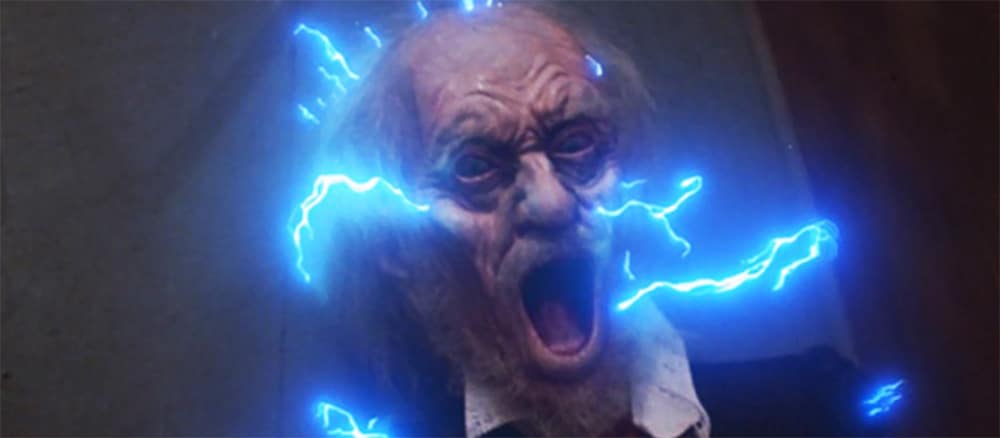
Thankfully, Halloway manages to escape the Dust Witch before deterring Jim’s mother from entering the hall of mirrors, where he himself enters to challenge Dark. After successfully resisting the temptation of being made young again and accepting his mistakes, Halloway rescues Jim from the carousel just as a bolt of lightning hits the control box, causing the carousel to speed forward at an accelerated rate with Mr. Dark still on it.
In probably the most disturbing Disney special effects sequence of all time (in one of its kids’ movies, at least), Mr. Dark ages at a fantastic rate before the carousel stops and his skeletal remains fall to the ground.
I always found it interesting and disturbing that Angelo Rossitto’s character then comes and carries off the remains as the carnival goes up in flames, almost as if they were leaving the door open for a sequel.
In the meantime, Jim has been knocked unconscious and may have even been affected by the lightning because he is unresponsive, so Will and his father figure out that the way to defeat the evil energy that keeps Dark and his carnival alive is to negate their sadness with joy.
Jim is revived, the townspeople are freed, and the carnival fades into nonexistence.
FINAL THOUGHTS
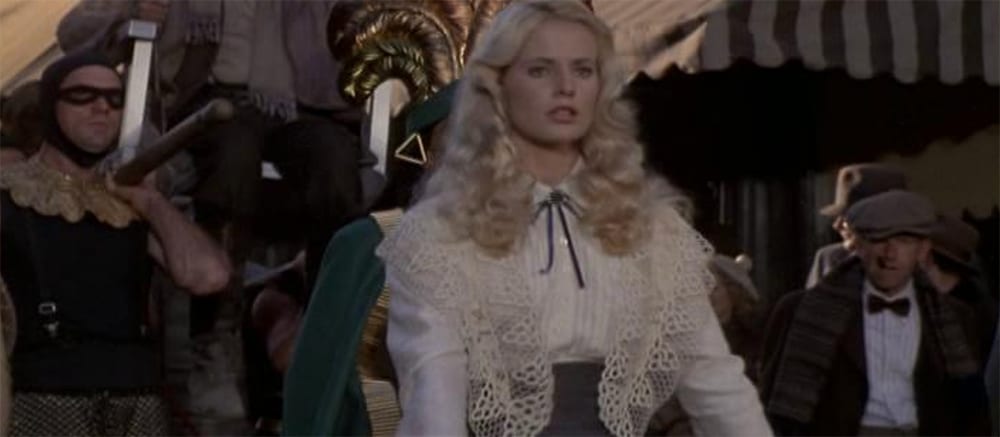
And as Charles, Will, and Jim danced and skipped their way home and the narrator said his final words, Something Wicked This Way Comes was forever etched into my memory.
I put it in the same category as other coming-of-age films like Stand by Me, Stephen King’s IT, Explorers, and The Goonies. I am so glad I saw it as a child and that Disney took a chance with the story, even though the film’s production was plagued with issues, and it wound up making only $8.4 million at the box office against its estimated $20 million budget.
Bradbury and others have rightly called Something Wicked This Way Comes the best adaptation of one of Bradbury’s works, and Bradbury himself said, “Not a great film, no, but a decently nice one,” which, for a live-action Disney film from the early ‘80s is about as good as one could expect.
Because of its limited distribution and several years of unavailability (except to Disney Channel subscribers), it has become something of a cult classic and is remembered fondly by many who did manage to catch it at least once during its original run or on cable.
It is available on DVD, laserdisc (the best version), and Blu-ray. It’s also available in lower quality on YouTube.
There are so many more little factoids I could share with you about Something Wicked This Way Comes, but I strongly encourage anyone who has not seen it in many years or at all to seek it out, including the aforementioned commentary.
Give this unsung classic another chance, if not just for the nostalgia, then for the warm autumn feeling you get from the gorgeous matte paintings and the soundtrack, as well as the sublime performances from Robards, Grier, and Pryce.


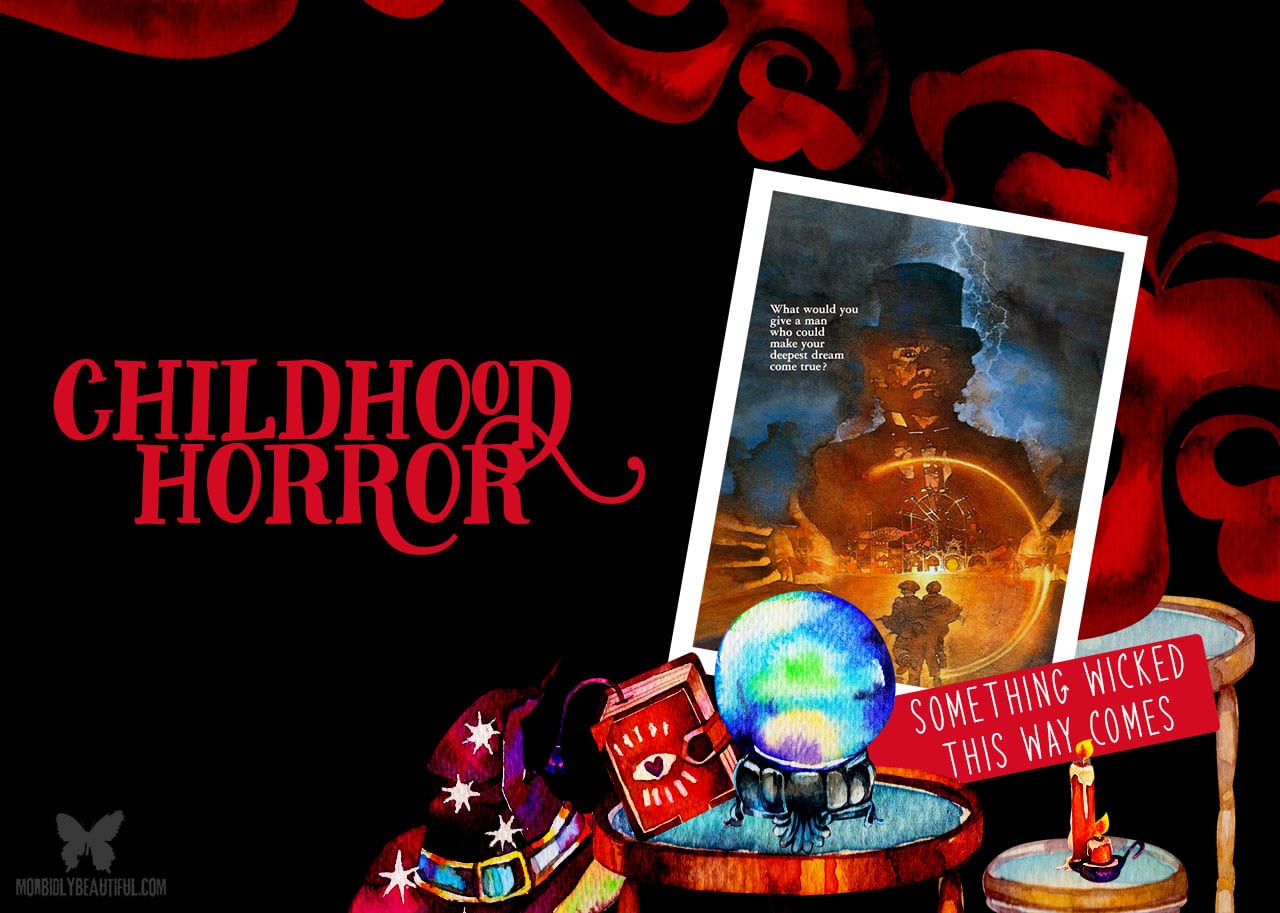
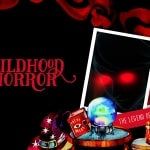
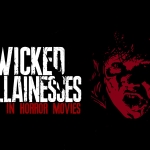
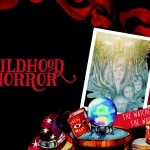
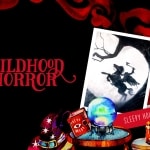





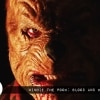
Follow Us!